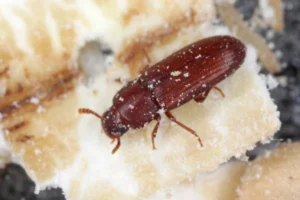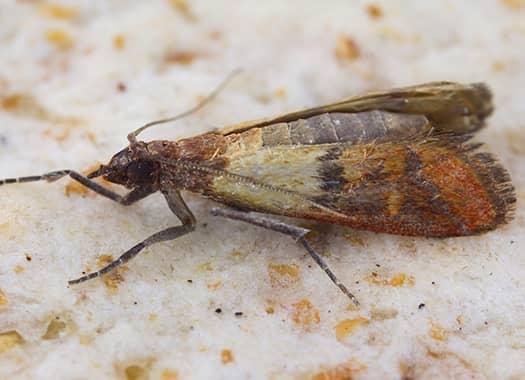Stored Product Pests Can Wreak Havoc on Your Food Inventory by Damaging and Contaminating Product
Stored product pests can wreak havoc on your food inventory by damaging and contaminating products, costing you money and customers, damage to your brand, and putting you at risk for a failed audit.
Sometimes hard to spot, stored product pests can go undetected until they chew through packaging or lay eggs in raw materials or damage stored inventory. How much havoc can they cause in a food processing or storage facility or grocery store?

Red flour beetles in almond and flour production facilities.
According to research from the USDA, stored product pests damage, contaminate or consume as much as 10 percent of the total food produced in the United States. That translates into millions of dollars of spoiled product, lost sales and brand damage.
How can facility and QA managers prevent stored product pests from spoiling the party? Jeff Weier, a technical consultant for Sprague and one of the country’s foremost stored product pest experts, says the key is exclusion and prevention.
“Exclusion isn’t just for rodents or birds, it applies to stored product pests as well,” says Weier. “Preventing stored product pests from physically gaining access to your facility not only will protect your products but save you money in the long run.”
Two examples of pest prevention strategies for fall include practicing good inventory management and equipment cleaning.
“Fall is a good time of year to review your inventory and look for ingredients that are out of specification or were put aside during the production process earlier this year,” says Weier. “These ingredients may not have been stored properly and thus are at an increased risk of infestation.”
Weier says food processors also deploy different production equipment in the fall. This means bringing in equipment – augers, conveyors, grinders – that may have been stored outside or weren’t cleaned properly. The equipment could be infested and unknowingly introduce stored product pests into the facility.
Signs of Stored Product Pests
Stored product pest populations peak in the fall after a summer’s worth of warm, humid temperatures. The increase in activity levels raises the threat level as moths and beetles look to infest grain, seed, spices, flour, dried fruits, rice, cereal, dry pasta, breads, tobacco, pet food, birdseed and chocolate.
Weier says Sprague team members have noticed increased levels of Indian meal moth and cigarette beetle activity recently as well as continued pressure from red flour beetles in almond and flour production facilities.
What are the signs of a possible stored product pest infestation and where are they found?
- Crawling larvae in potential food sources and Indian meal moths flying near infested products.
- Stored product pests can be found in box seams, between bags, and under liners or pallets.
- Stored food pests thrive in the smallest of food sources; spills that accumulate in floor cracks, equipment, hollow posts, and rack joints are particularly vulnerable, so look there for infestations.
Stored Product Pests Prevention Tips
Facility and QA managers in grocery stores, mills, processing plants, or bulk storage facilities should understand their options for preventing and eliminating stored product pests.
In addition to exclusion strategies – keeping doors and windows closed, installing screens over ventilation openings, installing door sweeps, ensuring proper air flow – thorough inspections of incoming shipments and consistent monitoring with insect light and pheromone traps are keys to preventing stored product pest infestations.
“Inspecting areas where stored product pests have been captured using insect light or pheromone traps is the first step to identifying the source of the infestation,’ says Weier. “Captures can change depending on what products are being produced at the time, but the data provided will point you in the right direction and allow you to reach a solution sooner.”
Weier says the source of an infestation is not limited to a torn sack of flour but could include the hollow leg of a piece of processing equipment, cracks in the floor or HVAC ducts where dust or food debris may have collected.
Preventive steps to head off stored product pests include the following:
- Carefully inspect incoming shipments for signs of pest activity. Torn packaging or broken seals can provide pests with access to food products
- Moderate the temperature of storage areas. The ideal temperature should range between 50°F and 65°F – the cooler the better.
- Store sacks of grain, flour and other food products off the floor.
- When storing or moving food products within the facility, use storage containers that can be sealed to deny pests access.
- Observe the first-in, first-out rule of inventory. Rotate products frequently, and do not store food products, especially those in paper or cardboard containers, for extended periods of time.
- When storing product do not mix old and new food products. If the old product is infested, the insects will be transferred immediately to the non-infested product.
- Stored product pests can be small and hard to see and can hang on in empty containers. A thorough deep cleaning of mixing, storage or transportation equipment should be done before the equipment is reused.
- Practice good sanitation in your facility. Clean up spilled food and eliminate conditions that pests find attractive.
- If an infestation is found, immediately discard the infested food and check surrounding food products for cross-contamination.
- Date and rotate stock and remove all out-of-code inventory. Use the “first in, first out” method.
Discover The Sprague Difference
For more information on how Sprague Pest Solutions can assist you establish an effective stored product pest prevention or management program in your commercial property, call 855.805.0755.

